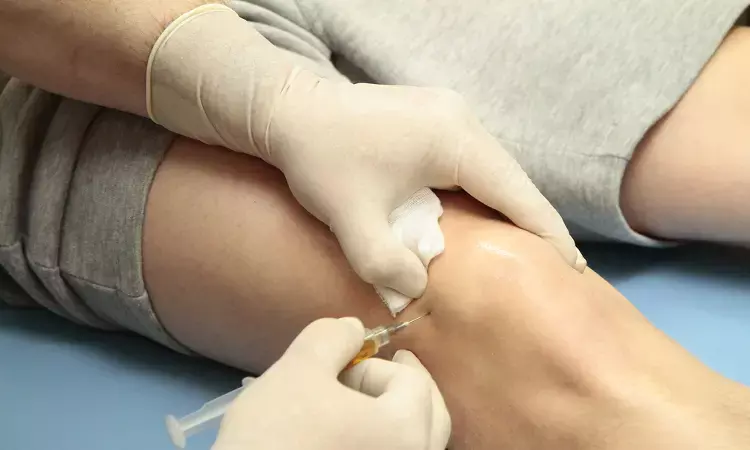- Home
- Medical news & Guidelines
- Anesthesiology
- Cardiology and CTVS
- Critical Care
- Dentistry
- Dermatology
- Diabetes and Endocrinology
- ENT
- Gastroenterology
- Medicine
- Nephrology
- Neurology
- Obstretics-Gynaecology
- Oncology
- Ophthalmology
- Orthopaedics
- Pediatrics-Neonatology
- Psychiatry
- Pulmonology
- Radiology
- Surgery
- Urology
- Laboratory Medicine
- Diet
- Nursing
- Paramedical
- Physiotherapy
- Health news
- Fact Check
- Bone Health Fact Check
- Brain Health Fact Check
- Cancer Related Fact Check
- Child Care Fact Check
- Dental and oral health fact check
- Diabetes and metabolic health fact check
- Diet and Nutrition Fact Check
- Eye and ENT Care Fact Check
- Fitness fact check
- Gut health fact check
- Heart health fact check
- Kidney health fact check
- Medical education fact check
- Men's health fact check
- Respiratory fact check
- Skin and hair care fact check
- Vaccine and Immunization fact check
- Women's health fact check
- AYUSH
- State News
- Andaman and Nicobar Islands
- Andhra Pradesh
- Arunachal Pradesh
- Assam
- Bihar
- Chandigarh
- Chattisgarh
- Dadra and Nagar Haveli
- Daman and Diu
- Delhi
- Goa
- Gujarat
- Haryana
- Himachal Pradesh
- Jammu & Kashmir
- Jharkhand
- Karnataka
- Kerala
- Ladakh
- Lakshadweep
- Madhya Pradesh
- Maharashtra
- Manipur
- Meghalaya
- Mizoram
- Nagaland
- Odisha
- Puducherry
- Punjab
- Rajasthan
- Sikkim
- Tamil Nadu
- Telangana
- Tripura
- Uttar Pradesh
- Uttrakhand
- West Bengal
- Medical Education
- Industry
Intra-articular Ketamine reduces Post Operative Pain and Reduces Opioid usage

Ketamine's routine perioperative care has become popular since first being synthesized in 1962 by Calvin Stevens. The use of S-ketamine is increasing worldwide since the S(+)-enantiomer has been postulated to be a four times more potent anesthetic and analgesic than the R(-)-enantiomer and approximately two times more effective than the racemic mixture of ketamine.
In a recent study published in the American Journal of Physical Medicine & Rehabilitation, researchers have reported that the patients who received intra-articular ketamine generally reported lower pain scores and had lower postoperative opioid consumption after orthopedic joint procedures.
Ketamine is being explored for alternative treatment options for medical conditions such as headaches, depression, and chronic pain. Because of extensive first-pass metabolism, oral bioavailability is poor and ketamine is vulnerable to pharmacokinetic drug interactions. Sublingual and nasal formulations of ketamine are being developed, especially nasal administration produces rapid maximum plasma ketamine concentrations with relatively high bioavailability. However, ketamine is commonly used in the intravenous form for postoperative pain control but, its use as an intra-articular (IA) agent is fairly novel. Therefore researchers of Mayo Clinic, Minnesota, conducted a study to appraise the evidence from human clinical trials comparing postoperative pain scores and opioid consumption in patients receiving intra-articular ketamine versus other modalities of analgesia after orthopedic joint procedures.
It was a systemic review of seventeen studies from Embase, Scopus, and OVID Medline databases. From these studies, researchers compared patients receiving intra-articular ketamine versus other modalities of analgesia. The major outcome assessed was postprocedural pain score and total opioid consumption. Researchers also assessed the time to rescue analgesic medication request, active range of motion, time to mobilization, and adverse effects. Dosage of ketamine varied widely from 0.25 to 2 mg/kg.
Among 17 studies, researchers noted that 15 studies demonstrated decreased overall pain scores and decreased total postoperative opioid consumption in patients receiving intra-articular ketamine versus control groups. They also found that patients who received intra-articular ketamin generally demonstrated reduced time for mobilization and increased latency until rescue analgesic medication.
The authors concluded, "Patients who received intra-articular ketamine generally reported lower pain scores and had lower postoperative opioid consumption after orthopedic joint procedures".
They further added, "The findings suggest that the intra-articular route of ketamine delivery may be a useful analgesic modality, although future larger-scale trials should explore its pharmacokinetics, optimal dosing, safety, and cost-effectiveness".
For further information:
https://journals.lww.com/ajpmr/fulltext/2020/11000/a_systematic_review_of_intra_articular_ketamine.13.aspx
Medical Dialogues Bureau consists of a team of passionate medical/scientific writers, led by doctors and healthcare researchers. Our team efforts to bring you updated and timely news about the important happenings of the medical and healthcare sector. Our editorial team can be reached at editorial@medicaldialogues.in.
Dr Kamal Kant Kohli-MBBS, DTCD- a chest specialist with more than 30 years of practice and a flair for writing clinical articles, Dr Kamal Kant Kohli joined Medical Dialogues as a Chief Editor of Medical News. Besides writing articles, as an editor, he proofreads and verifies all the medical content published on Medical Dialogues including those coming from journals, studies,medical conferences,guidelines etc. Email: drkohli@medicaldialogues.in. Contact no. 011-43720751


